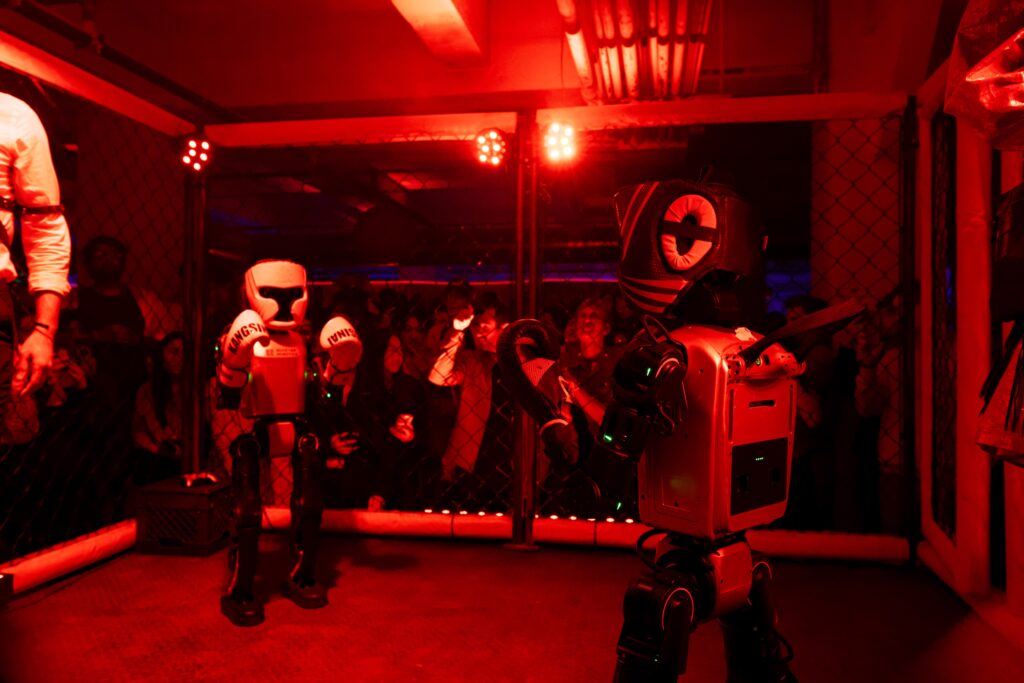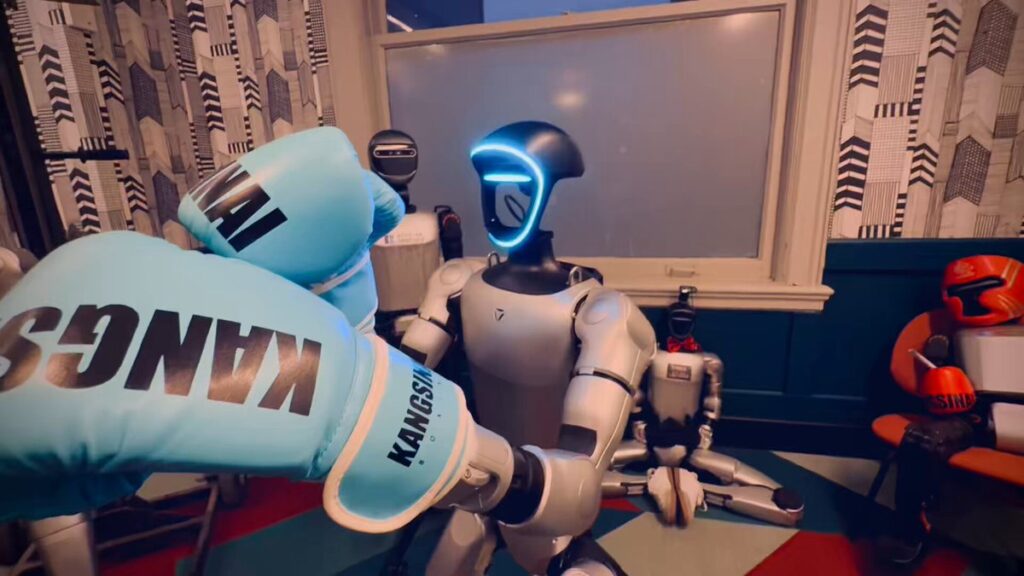San Francisco has always been a playground for innovators, dreamers, and tech rebels. But now, there’s a new badge of honor for the city’s elite an invite to the underground robot fight club. Last Friday night, beneath the sleek glass and steel of Frontier Tower on Market Street, the basement transformed into a neon lit.
Cyberpunk arena where humanoid robots clashed in front of a roaring crowd of techies, artists, and influencers. In an era where AI art, crypto fortunes, and startup culture dominate headlines, this robot fight club feels like the perfect fusion of spectacle, innovation, and rebellion.
The Night the Machines Took the Ring
The atmosphere was electric from the moment you stepped in. Pink and red lights bathed the crowd in a warm, otherworldly glow. In the center of the room stood the cage ring, its chain link walls trembling slightly with every cheer. Inside, a Booster Robotics T1 humanoid bot squared off against a G1 humanoid from Unitree. Both wore comically oversized boxing gloves and helmets, giving them an oddly endearing and slightly unsettling appearance.
Even the traditional ring girl role had been reimagined. Instead of a human model, the audience was treated to a fishnet clad mannequin leg attached to a Roomba, scooting around the ring and vacuuming up dollar bills thrown by amused spectators. Only in San Francisco, one attendee whispered, shaking their head with a grin.
The Allure of the Underground
According to event organizer and tech entrepreneur Max Huang, the robot fight club wasn’t just about entertainment it was about creating a shared cultural moment for the city’s fractured tech scene.
We wanted to bring back the spirit of the early hacker meetups, Huang explained. Back then, it wasn’t about billion dollar valuations. It was about building something cool, showing it off, and having fun.
The guest list was selective, with invites spread quietly through Discord groups, encrypted Signal chats, and word of mouth. Being seen at the event let alone in the VIP section has quickly become a social currency among certain circles in SF.

A Glimpse Into the Future of Human Robot Entertainment
Dr. Elena Morales, a robotics researcher at Stanford, believes events like this are more than just quirky sideshows. We’re witnessing the first steps toward a new category of entertainment, she said. Just like esports took competitive gaming mainstream, physical robot competitions could become a legitimate spectator sport.
These humanoid robots are only going to get faster, smarter, and more lifelike. Morales also noted that costume design and character backstories could make robot fight club even more appealing to a wider audience, blurring the lines between robotics, cosplay, and live performance art.
From Maker Garage to Main Event
One of the robots in Friday’s fight, nicknamed Iron Pigeon, was the brainchild of a three person maker team from Oakland. They spent months modifying a Unitree G1, adding custom servos for faster punches and a lightweight exoskeleton for protection.
Originally, they tested the bot in a garage, sparring against other hobbyists’ creations. But after catching the eye of the Frontier Tower organizers, they were invited to debut in the official robot fight club arena.
It’s surreal said team member Jake Winters. We were just tinkering for fun, and now we’re performing in front of hundreds of people. It’s like BattleBots meets Burning Man.
The Human Connection Behind the Machines
While the stars of the show were undeniably mechanical, the real magic was in the people the engineers nervously tweaking settings between rounds, the artists who designed elaborate costumes, and the crowd itself, cheering as if they were watching old school boxing.
One attendee, UX designer Maya Chen, said she hadn’t felt this kind of community vibe in years. I’ve been to endless networking events, startup launches, and AI conferences, Chen said. But this? This was raw, unscripted, and fun. It reminded me why I fell in love with tech in the first place.
Why Robot Fight Club Matters
The rise of robot fight club speaks to a deeper cultural shift in tech hubs like San Francisco. As the city grapples with economic challenges, corporate layoffs, and debates over AI’s impact on jobs, events like this offer an antidote a reminder that technology can still be playful, creative, and social.
It also hints at the future of urban nightlife. Instead of passive entertainment, these events invite interaction, curiosity, and even participation. As robots become more sophisticated, matches could feature adaptive AI, player controlled fighters, or even crowd sourced move sets.
From a business perspective, this niche could evolve into a hybrid of esports and live performance, with sponsorships, streaming deals, and merchandise. Imagine a global league where custom built humanoids battle in arenas from Tokyo to Berlin.

The Ethical Question
Of course, no conversation about humanoid robots is complete without addressing the ethical implications. While robot fight club currently features non sentient machines, some experts warn about the slippery slope of normalizing violence toward humanoid forms.
Dr. Morales emphasized the importance of clear boundaries. We must ensure audiences understand these are machines with no consciousness. Once robots become more lifelike, the moral conversation changes. For now, the spectacle remains harmless fun a mash up of engineering skill and theatrical flair.
The Future Is Already in the Basement
As the final match ended and the crowd spilled out onto Market Street, the buzz was undeniable. Attendees swapped contact info snapped selfies with the robots and speculated about the next fight card.
The Frontier Tower basement may have returned to its coworking quiet by Monday morning, but those who were there will remember the night the machines danced, punched, and brought a jolt of excitement to San Francisco’s tech scene.
The robot fight club isn’t just about robots. It’s about reclaiming joy in a city that sometimes forgets how to play. And in a world racing toward an AI driven future, maybe that’s exactly what we need.

